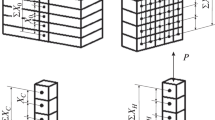Abstract
An experimental study of shape stability in wooden glued boards was performed to verify certain results of particular interest obtained earlier in numerical simulations. Possibilities for achieving products of good shape stability by gluing boards together in an optimal way are discussed. Since twist is often the most serious form of distortion defects for the user, it was the main type of board deformation considered. Three types of glued products were tested. The experiments show clearly that glued boards can be produced that remain stable in shape when exposed to extreme variations in moisture. The results agree well with the numerical simulations performed earlier. It was found that initial twist could be reduced by proper application of pressure during gluing and that through gluing the occurrence of cracking defects on visible surfaces could be substantially reduced.
Zusammenfassung
Eine experimentelle Untersuchung der Formstabilität von verleimten Brettern wurde durchgeführt, um bestimmte Ergebnisse, die in vorhergehenden numerischen Simulationen errechnet worden waren, zu verifizieren. Es handelt sich um Möglichkeiten, eine gute Formstabilität durch optimales Verleimen von Brettern zu erzielen. Da Verdrehung für den Verbraucher oft den unannehmbarsten Verformungsfehler darstellt, wurde dieser als Hauptfehlertyp berücksichtigt. Drei Arten von verleimten Holzprodukten wurden getestet. Die Experimente zeigen deutlich, dass verleimte Holzbretter hergestellt werden können, die bei extremen Feuchteschwankungen stabil bleiben. Die Ergebnisse zeigen eine gute Übereinstimmung mit den vorhergehenden numerischen Simulationen. Es wurde festgestellt, dass eine anfangs vorhandene Verdrehung durch geeignete Druckanwendung während des Verleimens reduziert werden konnte, und das Auftreten von Rissschäden auf sichtbaren Oberflächen durch Verleimen beträchtlich reduziert werden konnte.












Similar content being viewed by others
References
Anon. (1994) Nordic Timber—Grading rules for pine and spruce Timber (In Swedish: Sorteringsregler för sågat virke av furu och gran). Arbor Publishing, Stockholm
Forsberg D (1999) Warp, in particular twist, of sawn wood of Norway spruce (Picea abies). PhD thesis, Swedish University of Agricultural Science, Uppsala
Johansson G, Kliger R, Perstorper M (1993) Guidelines for purchasing building timber. (In Swedish: Förslag till inköpsregler för trävirke). Publ. S93:2, Dept. of Structural Engineering, Chalmers University of Technology, Gothenburg, Sweden
Johansson G, Kliger R, Perstorper M (1994) Quality of structural timber product specification system required by end-user. Holz Roh- Werkstoff 52:42–48
Johansson M (2000) Moisture-related distortion in Norway spruce timber—influence of material properties. Lic thesis, Chalmers University of Technology, Gothenburg
Kloot NH, Page MW (1959) A study of distortion in Radiata pine scantlings. Division of Forest Products, CSIRO, Technical Paper no. 7, Melbourne, Australia
Ormarsson S (1999) Numerical analysis of moisture-related distortions in sawn timber. PhD thesis, Chalmers University of Technology, Gothenburg
Ormarsson S, Dahlblom O, Petersson H, Eriksson J (2002) Computer analysis to design laminated timber products with good shape stability. Rpt. 02:8, Dept. of Structural Mechanics, Chalmers University of Technology, Gothenburg, Sweden
Serrano R, Cassens D (2000) Reducing warp and checking in plantation-grown yellow-poplar 4 by 4’s reversing part positions and gluing in the green condition. Forest Prod J 51:37–40
Woxblom L (1999) Warp of sawn timber of Norway spruce in relation to end-user requirements—quality, sawing pattern and economic aspects. PhD thesis, Swedish University of Agricultural Sciences, Uppsala
Author information
Authors and Affiliations
Corresponding author
Rights and permissions
About this article
Cite this article
Eriksson, J., Ormarsson, S. & Petersson, H. An experimental study of shape stability in glued boards. Holz Roh Werkst 62, 225–232 (2004). https://doi.org/10.1007/s00107-004-0468-z
Published:
Issue Date:
DOI: https://doi.org/10.1007/s00107-004-0468-z




